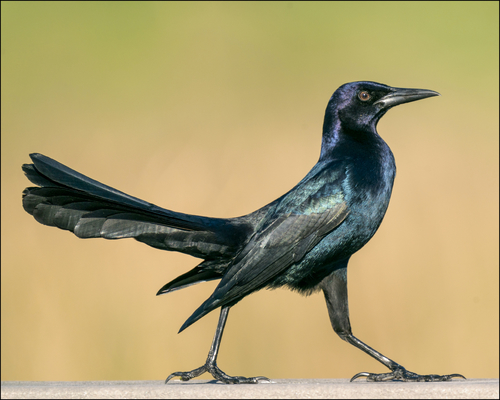
Boat-tailed Grackle
The Boat-tailed Grackle (Quiscalus major) is a large, striking blackbird found primarily in the southeastern United States, particularly along coastal areas. Known for their distinctive, keel-shaped tail, these birds are highly social and often form large, noisy flocks. They play a significant ecological role as both predators and seed dispersers, contributing to the balance of their coastal ecosystems. Culturally, they are sometimes viewed as a nuisance due to their bold behavior and tendency to raid crops, but they are also admired for their intelligence and adaptability.
37-43 cm
Length
44-56 cm
Wingspan
Least Concern
Conservation Status
Distribution
Primarily found along the Atlantic and Gulf coasts of the United States, from New York down to Florida and west to Texas. Some populations are also found in inland areas near large bodies of water.
Lifespan
Up to 14 years in the wild, though most live considerably shorter lives. Captive birds can live longer.
Boat-tailed Grackle's Habitat
Habitat Types
Salt marshes, Coastal scrub, Mangrove swamps, Estuaries, Agricultural fields (near the coast)
Climate Zones
Temperate, Subtropical
Adaptations
Boat-tailed Grackles are well-adapted to coastal environments. They have strong legs and feet for walking on uneven terrain and foraging in mud and shallow water. Their long bills are useful for probing for food in a variety of substrates.
Variations
Several subspecies are recognized, differing primarily in size and bill shape. For example, coastal populations tend to have larger bills than inland populations.
Appearance
Breeding Plumage
Little seasonal variation in plumage. Males are glossy black with a purple-blue iridescence. Females are a duller brownish-bronze color.
Seasonal Feather Changes
Minimal seasonal changes.
Sex Based Plumage Differences
Strong sexual dimorphism. Males are iridescent black, while females are brown above and paler below.
Notable Features
Long, keel-shaped tail (more pronounced in males), Bright yellow eyes in adults, Long, pointed bill
Diet and Feeding
Primary Foods
Insects, Crustaceans, Small fish, Seeds, Grains, Berries
Foraging Behavior
Boat-tailed Grackles are opportunistic omnivores. They forage on the ground, in shallow water, and in vegetation. They often probe mud and sand with their bills, and they are known to wade into water to catch small fish and crustaceans. They also glean insects from plants and readily consume seeds and grains.
Specializations
Their long bill is a versatile tool for probing and capturing a variety of prey items. They are also adept at manipulating objects with their feet.
Seasonal Diet Variations
Diet varies depending on food availability. During the breeding season, they may consume more insects and other invertebrates to provide protein for their young. In the winter, they may rely more on seeds and grains.
Behavior
Social Structure
Highly social, often forming large flocks, especially outside of the breeding season. Breeding colonies can be dense.
Communication
Loud, harsh calls, Chattering, Whistles, Visual displays (posturing, tail spreading)
Migration
Most populations are resident, but some northern populations may migrate short distances south in the winter.
Territorial or Group Behaviors
Males are territorial during the breeding season, defending their nesting areas from other males. Outside of the breeding season, they are highly gregarious.
Conservation
Threats
Habitat loss (due to coastal development and wetland drainage), Pesticide exposure, Climate change (sea-level rise affecting coastal habitats)
Protection Programs
Wetland restoration projects, Monitoring programs
Local National Laws
Protected under the Migratory Bird Treaty Act in the United States.
Population Trend
Stable
Population Estimates
The global population is estimated to be around 4 million individuals.
Interesting Facts
The 'boat-tail' is much more pronounced in males.
This feature is used in courtship displays to attract females.
Females are significantly smaller than males.
This is an example of sexual dimorphism, common in many bird species.
They are known for their intelligence and adaptability.
They have learned to exploit a variety of food sources and can thrive in human-altered environments.
Faqs about Boat-tailed Grackle
Are Boat-tailed Grackles aggressive?
Males can be aggressive during the breeding season when defending their territories. Otherwise, they are generally not aggressive towards humans, although they can be bold in their search for food.
What is the difference between a Boat-tailed Grackle and a Common Grackle?
Boat-tailed Grackles are larger, have a longer, keel-shaped tail, and are primarily found in coastal areas. Common Grackles have a shorter, flatter tail and a wider distribution.
Do Boat-tailed Grackles migrate?
Most populations are non-migratory, but some northernmost populations may move short distances south in winter.
What eats boat-tailed grackles?
Predators of Boat-tailed Grackles include birds of prey like hawks and owls, as well as snakes, raccoons, and other animals that may prey on eggs or nestlings.
Copyright @ Nature Style Limited. All Rights Reserved.
 English
English